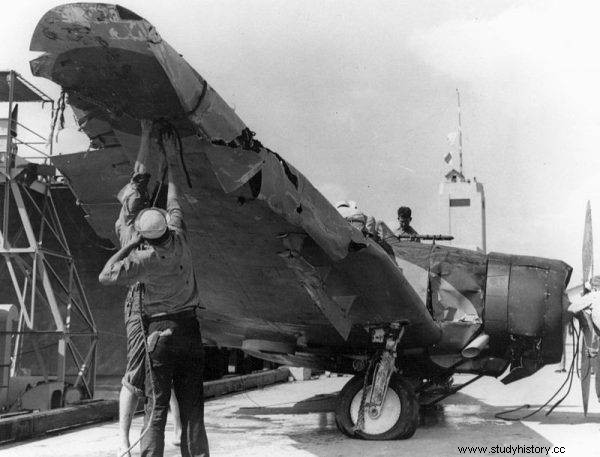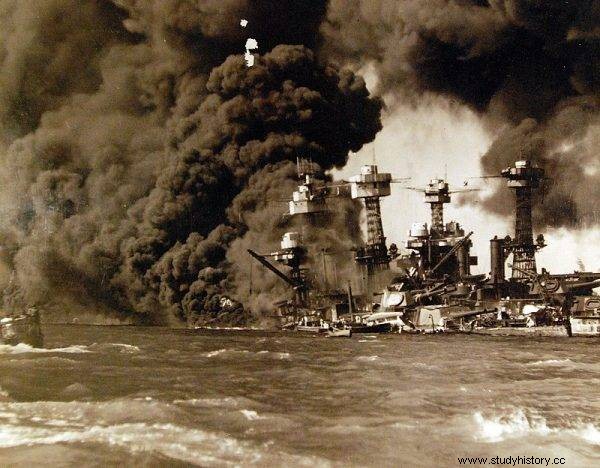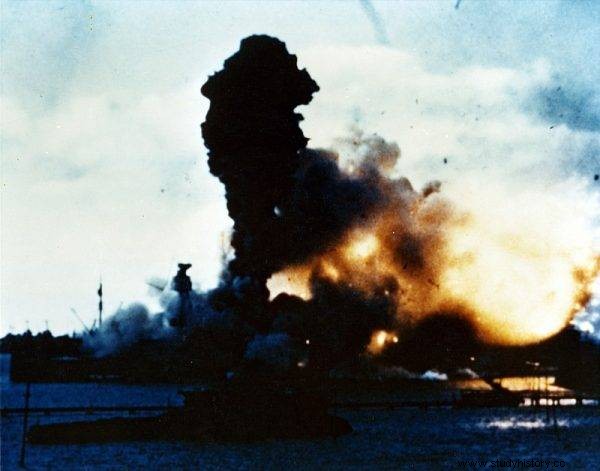The picture of the Japanese attack on Pearl Harbor presented over the years is false. Although in the morning of December 7, 1941, the Japanese actually surprised the Americans and massacred their fleet stationed at the Hawaii base, it quickly turned out that it was only a tactical victory, and the effects of the raid could be considered meager ...
The Americans lost only five battleships, three of which were later lifted from the bottom and overhauled. The most important thing, however, was that the aircraft carriers that later won the war with Japan survived. The Americans built 141 aircraft carriers by the end of the conflict, Japan - only 26!
A conspiracy against America?
At the end of 1941, almost the entire Old Continent was already under German occupation. In the West, only Great Britain, which managed to defend itself against the invasion, resisted, in the East Hitler's troops approached Moscow. Europe was at war not only in Europe. Italian and German troops fought with British troops in North Africa, and offensives and counter-offenses rolled through the territory of Libya and Egypt one way and the other.
Bloody slaughter also took place on the water:in the Atlantic, North, Norwegian and Mediterranean seas, U-boats were prowling, drowning allied ships by the dozen. Large German surface ships also made expeditions to the ocean, e.g. "Bismarck", "Prinz Eugen", "Scharnhorst" and "Gneisenau".
Meanwhile, on the other side of the ocean did everything not to get involved in another "brawl" in distant Europe. Typical American life was going on in the cities, the economy was booming, no windows were required to be blacked out, sirens weren't sirens, and factories were running normal "peaceful" production.

One of the Japanese planes used in the attack.
The United States at all costs wanted to avoid a situation where once again - as during World War I - thousands of American soldiers would be killed on another continent. Society categorically demanded the authorities to remain neutral, and sometimes even showed sympathy for "Mr. Hitler" and his Third Reich.
Netflix's exquisite series "Conspiracy Against America" contains a grain of truth! Not only citizens, but also congressmen were watching the president so that he would not get into some stupid war trouble . It is true that international relations experts were sure that the US joining the war was only a matter of time, but none of them knew what had to happen for the Americans to take the Colt out of their pockets.
They were forced to do so by a certain Isoroku Yamamoto, a Japanese admiral, author of the attack plan on the Pearl Harbor base. He believed that the great Japanese offensive south - towards Indonesia, the Philippines and Australia - would be successful provided that American ships stationed in the Pacific were "grounded" for the long term. The Japanese wanted to have peace "behind their backs" to calmly conquer territories rich in resources and secure access to oil. Interestingly, they had been refused supplies of this raw material for some time by the United States, which indirectly forced Japan into a war.
Mobile Shock Forces
Yamamoto devised a plan for a complex offensive operation to be carried out by his powerful fleet. The big ships were supposed to be just a "hand", the "fist" of which were tiny planes taking off from the decks of aircraft carriers. The Japanese armada was to cross the half of the Pacific unnoticed and get close enough to Hawaii for the machines to bomb the American base and return to floating airports.
It was a bold move to send as many as six aircraft carriers into combat, which is everything that was available at that time. This type of solution was proposed by a young officer, Minoru Genda, under the influence of an analysis of an American propaganda film showing the maneuvers of four aircraft carriers operating as part of one squadron. Craig Symonds in his epochal work “World War II at Sea. Global History ”writes:
The concentration of six large aircraft carriers on one team was a serious departure from traditional views on the use of this type of unit. Both the Americans and the British sent their carriers on action one by one. When the two newest Japanese carriers joined the fleet in September, bringing their number to six, Yamamoto administratively merged them into one team, the 1st Aircraft Carrier Fleet. When they went into battle, they became Kidō Butai - which translates to "Mobile Shock Force".
Americans have for some time been able to read the content of secret Japanese telegrams sent from Tokyo to the embassy in Washington. While quite a few were deduced, there was no definitive confirmation that Japan would attack. Nevertheless, on November 27, Harold Stark, chief of naval operations, sent a warning to all commanders in the Pacific announcing that aggressive measures from the enemy could be expected in the coming days. In the next message, however, he warned not to take offensive actions until the enemy struck first.
Meanwhile, Yamamoto's large fleet, commanded at sea by Vice Admiral Chūichi Naguma, was already at sea. It had 33 ships, six aircraft carriers, two battleships, two heavy cruisers, nine destroyers, eight submarines, and numerous supply ships, including tankers. Submarines had gone to sea much earlier and were heading out into the waters near Hawaii. They carried a new generation of Japanese secret weapons on board - miniature submarines of the Ko-hyoteki type with a crew of 2–5 seamen. They were supposed to reach deep into the Pearl Harbor naval port and attack Americans also from under the water.
"Japanese intelligence estimated the Americans had a total of four aircraft carriers and eight battleships in the Pacific, and Yamamoto told Vice Admiral Nagumo that destroying half of these forces - two aircraft carriers and four battleships - would be a strategic success that would make Americans unable to interfere in the South Pacific." comments on Craig Symonds.
Blind and deaf interview
The usually well-informed Japanese intelligence service, however, got a little wrong this time. There were only two carriers at Pearl Harbor, because the Yorktown operated in the Atlantic and the Saratoga was undergoing refurbishment at a shipyard on the west coast. In addition, in response to a message from Stark, on November 28, the Enterprise set sail, which was sent "to the foreground" of Wake Atoll, located more than 3.5 thousand kilometers from Hawaii. In turn, on December 6, the "Lexington" departed to guard the Midway Atoll - 2,000 kilometers west of Pearl Harbor.
In the hours leading up to the attack, the Americans still had a chance to see that something was going on. The destroyer USS Ward spotted one of the Japanese miniature submarines heading towards the port entrance. "Ward" fired a gun and threw depth charges at the vessel and around At 6:45 he sank it and informed the base of the incident . There, however, some hardheaded staff officer decided that there was no question of a submarine in this area, and "Ward" attacked and sunk ... a whale.

USS West Virginia and USS Tennessee bombed by the Japanese
The Americans were sure that Hawaii was too far from Japan to be attacked first. For this reason, discipline on the ships and in the port was quite loose, the state of full readiness was not announced and only three planes were on reconnaissance patrols on the key day. The naval intelligence was also blind and deaf, because the Japanese kept radio silence all the way, and even the best cryptologists would not decode the messages unless they got them on their desks. Craig Symonds writes:
When Admiral Husband Kimmel asked his intelligence officer Commander Edwin Layton where the Japanese carriers were located, he had to admit he had no idea. Kimmel asked with mocking surprise:"What ?! You do not know?". Then he uttered a sentence that was later repeated over and over: "Are you saying that they could just be circling Diamond Head and you wouldn't know?".
Diamond Head is a volcano cone about 20 kilometers from Pearl Harbor, and on that side of the ocean, only 275 miles further north, was the Nagumo Armada hiding in the squall and fog - and from there on December 7 morning, Japanese planes flew in to arrange the Americans "Day of disgrace."
"Tor, tor, tor"
The Japanese prepared themselves perfectly for the attack. They attacked early Sunday morning, believing - rightly so - that the Americans would be sleepy and hungry at this early hour. For many months before the raid, Japanese pilots practiced dropping torpedoes in the shallow waters of Kagoshima Bay on the island of Kyushu. Wooden stabilizers were mounted in the torpedoes, thanks to which they submerged shallower and did not get stuck in the bottom, while for the bomber planes special charges were prepared, constructed on the basis of 406 mm anti-tank missiles from the heaviest ship guns.
The Japanese also knew that the heavy ships docked in pairs at the Pearl, so it was planned that the "outer" ships would be attacked with torpedoes, and those mooring at the quayside with bombs from divers and horizontal bombers.
On December 7, 1941 at 7.53 Lieutenant Commander Mitsuo Fuchida, commander of the first wave of attack, broke the radio silence by transmitting the predetermined signal "Torah, torah, torah" (Tiger, tiger, tiger), which meant complete surprise of the enemy . By the way, it is hardly surprising, since at this point Japan has not yet declared war on America, because it was supposed to happen only at 8 (how do we know it? - editor's note). Let's give Symonds the floor again:
Kate's horizontal bombers arrived at an altitude of three and a half thousand meters, while torpedo planes, flying 150 meters, circled around the anchorage to attack from the south. Almost all Americans who saw them assumed that they were their own planes to perform acrobatics. Then the first bombs exploded. Among the common confusion, formal procedures were omitted. On board the Nevada, it was announced through the ship's loudspeakers:"This is a real air attack by the Japanese, no balls!".
The battleships Maryland and Tennessee were hit first. Three charges exploded right outside the Arizona. The fourth hit. At 8:10 a.m., a bomb, or more precisely a converted 406 millimeter-caliber ship missile, dropped from a height of three and a half thousand meters, broke through the Arizona deck and reached the bow ammunition store, where it exploded.
A total of seven bombs fell on Arizona, four of which hit the deck. The ship sank in minutes, taking 1,177 sailors, most of the crew, to the bottom with her. Meanwhile, the torpedo planes, undisturbed by anyone, descended low to the water and dropped their "cigars". Seven torpedoes hit the USS California and five hit the USS Oklahoma. The Nevada, which had fired cauldrons, lifted the anchor and tried to sneak out, but was hit by five bombs and one torpedo. So the captain decided to run the ship aground.
After the first wave of the air raid, another came, which was to complete the destruction and finish off the damaged ships. However, this time the Americans were prepared - they fired fighters that shot down 24 Japanese machines in time.
Nevertheless, as a result of the attack, four battleships were sunk and 18 ships were damaged. The Americans also lost 188 aircraft, most of them destroyed on the ground. 2,403 American soldiers and sailors died, most notably from the USS Arizona. 429 people were lost on the Oklahoma, 100 on board the California and 106 on the West Virginia. Japanese miniature submarines that broke into the port had no success, their torpedoes missed.
Balance of losses
“The Japanese have had a greater victory and less casualties than even their most optimistic planners imagined. Earlier estimates assumed the loss of two of their own aircraft carriers - a third of the Kidō Butai. Meanwhile, only twenty-nine planes and five miniature submarines were lost, ”Craig Symonds writes about the results of the raid. Let us add that the Japanese lost only 65 people (pilots and sailors from miniature submarines). One soldier was captured.
Huge American losses and small Japanese losses are true, of course, but not all. Without knowing the full picture, we imagine - because such a false picture is given to us by pop culture - that the attack on Pearl Harbor was such a powerful blow for America that it staggered over it. Nothing similar! Yes, human losses were large, but ship losses and damage to technical infrastructure - minimal!

In December 1941, the Americans were surprised by the Japanese.
First of all, Japanese bomber and torpedo planes did not find the most valuable ships in the base - aircraft carriers, so they could not destroy or even damage them. The surviving aircraft carriers then inflicted numerous losses on them, incl. in the Battle of the Coral Sea or at Midway. At the time of the attack on Pearl Harbor, both sides realized that in the conflict waged over the vast areas of the Pacific, the aircraft launched from the carriers would be more important than the heaviest cannons of the largest ships.
The pilots dispatched by Naguma made two big mistakes. First, they didn't attack and destroy the huge fuel tanks at the base. Secondly, no port facilities such as cranes, docks and hoists were affected by their bombs, and they were working at full speed a few hours after the raid, announcing their future doom to the Japanese.
Nagumo, who was a timid and conservative commander, did not decide to carry out the third raid aimed at the port facilities. Although he had all the trump cards in his hand, he did not act adequately to the situation on the battlefield, turned his tail and returned to Japan.
An important circumstance for Americans was the fact that the sinkings took place in a port and not on the high seas. As a result, most of the damaged ships were saved, and three:USS California, USS Nevada and USS West Virginia, were lifted from the bottom in the first half of 1942 and returned to active service after repairs! Oklahoma was also brought to the surface, but its renovation was deemed unprofitable. Arizona stayed where it was, and in 1962 its wreckage was converted into a monument. (If you ever arrive in Hawaii, it's worth knowing that the USS Arizona Memorial is free because it's a war cemetery.
The giant awakens
The day after the attack on Pearl Harbor, President Franklin Delano Roosevelt spoke to the Americans with these words:"Yesterday, December 7, 1941 - on a day of disgrace - the United States of America was deliberately attacked by the naval and air forces of the Japanese Empire in an unprovoked and cowardly attack. . I regret to inform you that many Americans have lost their lives. Therefore, I am asking Congress to declare a state of war between the United States and Japan. "
Admiral Yamamoto, who knew the Americans well because he had studied in the US for several years, said:"I'm afraid all we've done is awaken the sleeping giant and fill it with terrible determination." In this case, Yamamoto was right:
The attack caused the United States, with its enormous industrial potential, to fully engage in the conflict and to such an extent outraged American public opinion that only the ultimate Allied victory could reassure her which Roosevelt in his December 8 address to Congress called a "total victory".
The economic potential of the "awakened giant" is evidenced by the fact that in total the Americans produced 141 aircraft carriers (key ships in this war) by the end of the war. Japan, although it wanted and tried very much, only built 26 of them, and there were not enough planes for the ships built in the last years of the war. The final "retribution" of the Americans for the attack on Pearl Harbor was the dropping of atomic bombs on Hiroshima and Nagasaki.
